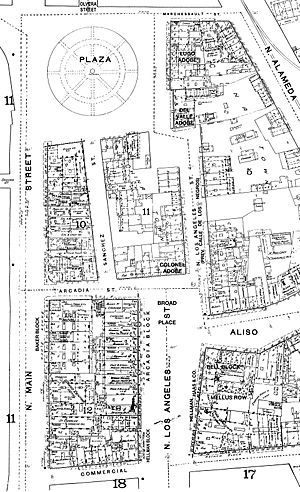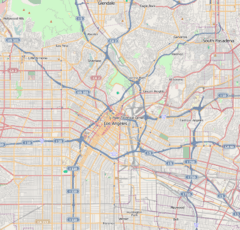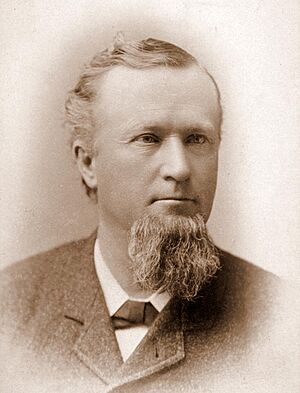Los Angeles Chinese massacre of 1871 facts for kids
Quick facts for kids Los Angeles Chinese massacre of 1871 |
|
|---|---|
| Location | Los Angeles, California, U.S. |
| Coordinates | 34°03′24″N 118°14′16″W / 34.056583°N 118.237806°W |
| Date | 24 October 1871 |
| Target | Chinese immigrants |
|
Attack type
|
Massacre |
| Deaths | 19 |
| Perpetrators | Mob of around 500 non-Chinese men |
| Motive | Racially motivated, revenge for the accidental killing of Robert Thompson, a local rancher |
The Los Angeles Chinese massacre of 1871 was a terrible attack on Chinese immigrants. It happened in Los Angeles, California, United States, on October 24, 1871. About 500 white and Hispanic Americans attacked, robbed, and killed Chinese people. This happened in the old Chinatown area of Los Angeles.
The attack took place on a street called Calle de los Negros. This street was also known as "Negro Alley." The large crowd gathered after hearing that a police officer and a rancher had been killed. These deaths happened during a fight between two rival Chinese groups called the Nin Yung and Hong Chow. As news spread, rumors said that the Chinese community "were killing whites wholesale." More people joined the angry crowd around Negro Alley. Some historians today say this was the largest mass killing by a mob in American history.
Nineteen Chinese immigrants were killed. Fifteen of them were killed by the mob during the riot. These deaths were more than 10% of the small Chinese population in Los Angeles at that time. Before the massacre, there were only 172 Chinese residents. Ten men from the mob were put on trial. Eight were found guilty of killing people without planning to. However, their convictions were later canceled because of small legal mistakes.
What Happened
The Los Angeles Chinese Massacre of 1871 was a very violent event. Los Angeles was a small town then, with only 5,728 people. A disagreement within the Chinese community led to a fight. This fight resulted in the death of an American bystander and a police officer getting hurt. This sad incident caused a wave of anger and destruction. It was focused on Calle de Los Negros. This was an old alley known for Chinese homes, businesses, and gambling places.
Most of the Chinese victims killed in the massacre were not involved in the original fight. After the chaos, many people were identified as being part of the violence. A jury later identified seven men to be tried for their direct involvement. Judge Robert M. Widney found them guilty of lesser charges, like killing without planning. They were sentenced to prison for two to nine years. But an appeal to the California Supreme Court overturned these decisions. The cases were sent back to Judge Widney's court. The District Attorney decided not to try the cases again. So, the accused men were set free in the spring of 1873. This event is a dark part of Los Angeles history.
The massacre started because of a fight between two rival Chinese groups. These groups were the Nin Yung and Hong Chow. They were fighting over a woman named Yut Ho. Police had sometimes helped these groups before to settle disputes over women. But this time, things got out of control. The conflict grew for two days. It led to the deaths of Jesus Bilderrain, a police officer, and Robert Thompson, a civilian.
Soon after, a large crowd gathered around the Coronel Adobe building. This was where the events were happening. People started shooting without caring who they hit. The violence caused many injuries and deaths on both sides. It also spread to at least three other areas. Some people, like Robert M. Widney, who later became a judge, tried to calm the situation. The police, led by Sheriff James F. Burns, were only able to stop the violence hours later. After that, the legal system began to gather facts to punish those responsible.
Why It Happened

Discrimination against Chinese immigrants was growing in California. This is seen as a main reason for the massacre. White residents in Los Angeles did not like the growing Chinese population. They saw them as outsiders. In 1863, a state law was passed. It said that Asians could not speak in court against white people. This made Chinese people very vulnerable to unfair treatment. It also meant they could not get justice through the law.
In 1868, the United States signed a treaty with China. This treaty set rules for immigration. At that time, most Chinese workers who came to the U.S. were men. They planned to stay only for a short time. The small Chinese community in Los Angeles had fewer than 200 people. About 80% of them were men.
Another reason was the wild nature of Los Angeles back then. In the 1850s, the city had many mob killings for its size. People often believed in "popular justice," meaning mobs took justice into their own hands. This was also a time of violence across the country. The city attracted many people who moved around a lot.
In the days before the riot, two Chinese groups, the Hong Chow and Nin Yung, started fighting. They were arguing over a Chinese woman named Yut Ho. Police had helped these groups before to keep their fights private. They sometimes even returned women who had run away, in exchange for money. But this time, things got out of hand. Two Chinese men were arrested for shooting at each other. They were released on bail. But the police kept an eye on the old Chinatown neighborhood. This area had grown along Calle de los Negros.
Calle de los Negros
Calle de los Negros was a street near Los Angeles's main business area. It was about 500 feet long. It was named by Spanish settlers for darker-skinned Californians who lived there. By the 1860s, when the first Chinatown grew there, the neighborhood had become a poor area.
A merchant named Harris Newmark said that Calle de los Negros was "as tough a neighborhood... as could be found anywhere." A historian named Morrow Mayo described it in 1933 as:
- a terrible street, forty feet wide.
- It was full of bars, gambling houses, dance halls, and other places.
- It was crowded day and night with people of many races.
- People rushed from one place to another, from bar to bar.
- There was a band in every place, with harps, guitars, and other stringed instruments.
The Riot Begins
On the afternoon of October 24, court hearings were held about a shooting in Negro Alley the day before. After the hearing, the people involved went back to Negro Alley.
About an hour later, Constable Jesus Bilderrain heard shots. He rode towards Negro Alley. He saw a group of Chinese men shooting at each other. He tried to arrest a Chinese man with a gun. Another group of men went into the Coronel Adobe building and shot at others. While taking the arrested man to jail, Bilderrain saw another Chinese man with a pistol. He tried to arrest him. This man shot at Bilderrain and closed the door.
Bilderrain and another officer went into the building. They met a group of armed men. Bilderrain was shot in the shoulder. Both officers had to retreat. A group of men chased Bilderrain out of the building. Once outside, Bilderrain blew his police whistle for help. Three men came out of the adobe and shot at Bilderrain again. One shot hit another person in the leg.
At this time, Robert Thompson appeared and came near the door. Officers warned him to stay back. Thompson fired two shots into the store. One shot from inside hit Thompson. He said, "I'm killed." He later died. The men inside, Sam Yuen and his brother, escaped disguised as cooks.
After the shooting stopped, the doors to the Coronel Adobe were closed. The City Marshal assigned men to guard the house. They were told not to let any Chinese men leave. Guards were placed around Chinatown to stop anyone from escaping. When news of Thompson's death spread, along with the rumor that Chinese people "were killing whites wholesale," more men gathered.
The Mob's Actions
The first victim of the mob was Ah Wing. The crowd caught him. A marshal searched him and found a gun. The marshal took the gun and let him go.
Ah Wing was caught again soon after, this time with a hatchet. A constable took charge of Ah Wing. He and another man walked Ah Wing towards the jail. About 100 men followed them. At an intersection, the crowd took Ah Wing. They led him to Tomlinson's Corral and killed him by hanging him from a gate.
Later, another door opened in the Coronel Adobe. A Chinese man rushed out. Thirty or forty shots were fired. He fell less than ten feet away. Another man inside the house looked out a window. Several people came up and shot into the window with shotguns and pistols.
Men started climbing the building with a ladder. They cut holes in the roof with axes. Men on the roof shot at the Chinese people in the backyard. Then, they started firing through the ceiling into the rooms. This made the people inside run out of the house.
One man ran out of the house, and the mob on the street started firing. He crawled back inside. Someone threw a burning ball dipped in alcohol into the room. Then, they went in, found the wounded man, and carried him across the street. The crowd then gained courage and entered the building. They found two Chinese men in that room and pulled them out. The crowd started breaking down doors and taking out the people inside.
Groups of men started leading Chinese people away from Negro Alley. Some officers told groups to take the Chinese to jail for safety. Some groups did take their captives safely to the county jail. But other groups led men to Tomlinson's corral or John Goller's wagon shop to be killed. Some people tried to stop the mob, but it was no use. A few men managed to rescue some Chinese people from the mob. Around 9:20 P.M., the Sheriff asked for volunteers to help keep the peace and guard the building.
The End of the Riot
Rioters climbed onto the roofs of buildings where Chinese immigrants lived. They used tools to make holes in the roofs and shot at the people inside. Those who ran outside were also shot by gunmen on the roofs. Many were also beaten and hurt badly.
By the end of the riot:
- Dead Chinese people were hanging in three places.
- Some were hanging from a wooden awning over a sidewalk.
- Others were hanging from the sides of two wagons parked on the street.
- More were hanging from a gate leading into a lumberyard.
The mob destroyed almost every Chinese-owned building on the block. They attacked or robbed nearly every Chinese resident. In total, 19 Chinese immigrant men were killed by the mob.
Aftermath
Authorities arrested and put ten rioters on trial. Eight were found guilty of killing people without planning to. They were sent to prison. But their convictions were canceled later because of a small legal mistake. The eight men who were found guilty were:
- Alvarado, Esteban
- Austin, Charles
- Botello, Refugio
- Crenshaw, L. F.
- Johnson, A. R.
- Martinez, Jesus
- McDonald, Patrick M.
- Mendel, Louis
The event was widely reported in newspapers across the country. Newspapers on the East Coast called Los Angeles a "blood stained Eden" after the riots. A growing movement against Chinese people in California led to the Chinese Exclusion Act of 1882. This law stopped Chinese workers from coming to the United States.
Calle de los Negros was renamed part of Los Angeles Street in 1877. It was completely changed in 1888 when Los Angeles Street was made wider. The Coronel Adobe building, where the massacre happened, was torn down in the late 1880s. Today, the old site of the Coronel Adobe is roughly in the middle of North Los Angeles street.
In Popular Culture
L.P. Leung wrote a book called The Jade Pendant (2013) about a main character involved in the 1871 massacre. This book was made into a Chinese film with the same name. The movie was released in 2017 in North America.
Images for kids
See also
 In Spanish: Masacre de chinos de Los Ángeles para niños
In Spanish: Masacre de chinos de Los Ángeles para niños




